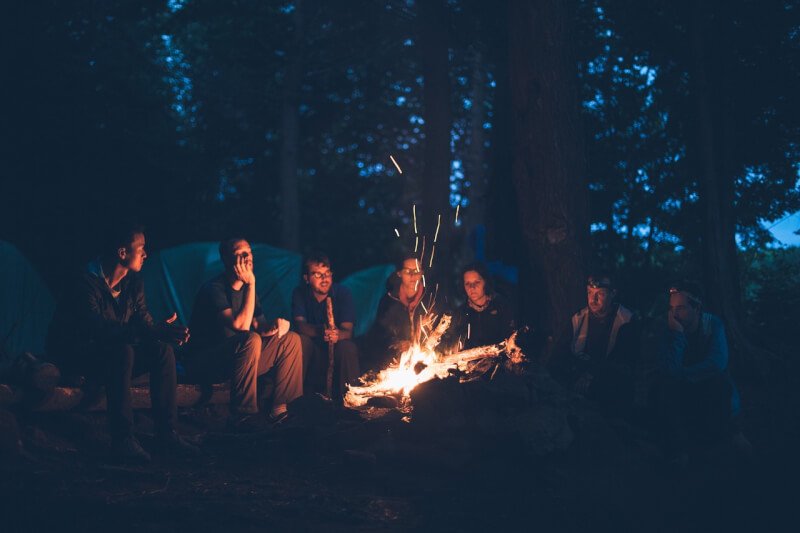Imagine yourself sitting around a crackling campfire, surrounded by the peaceful silence of the great outdoors. The stars twinkle above as you listen intently to the stories being shared, each one filled with thrilling encounters with wildlife. From awe-inspiring encounters with majestic bears to playful squirrels stealing snacks, these camping adventure stories are guaranteed to transport you into the heart of nature and leave you craving your next outdoor escapade. So grab a marshmallow, get comfortable, and get ready to be captivated by these incredible wilderness tales.

1. Bear Encounters
1.1 Camping in Bear Country
Camping in bear country can be an exhilarating experience, but it’s important to remember that bears are wild animals and should be treated with caution and respect. When camping in bear country, it’s essential to follow certain guidelines to ensure your safety and the safety of the bears. First and foremost, always camp in designated campgrounds that have been approved for bear encounters. These campgrounds are equipped with bear-proof food storage lockers, which are essential for keeping bears away from your food and preventing them from becoming accustomed to human food.
1.2 Tips for Bear Safety
To stay safe while camping in bear country, it’s crucial to follow a few simple tips. Firstly, make sure to store all food and scented items securely in bear-proof containers. This includes not only your food but also things like toothpaste, deodorant, and even trash. Bears have an incredible sense of smell and can easily be attracted to the scent of food or toiletries. Secondly, when hiking or exploring the area, make noise to alert bears of your presence. This will help to avoid surprising them, which can lead to aggressive behaviors. Additionally, it’s always a good idea to hike in groups, as bears are more likely to avoid larger groups of people. Finally, if you do encounter a bear, remember to stay calm and avoid sudden movements. Slowly back away and give the bear plenty of space.
1.3 What to Do If You Encounter a Bear
Despite taking all the necessary precautions, there is still a chance of encountering a bear while camping. In such a situation, it’s important to know what to do to ensure your safety. If you come across a bear, the first and most crucial step is to remain calm. Avoid making eye contact and slowly back away, giving the bear a clear path to escape. It’s important not to run, as this may trigger a chase response from the bear. If the bear approaches you, try to appear larger by standing tall and waving your arms. Shout loudly to assert your presence and throw objects towards the bear, without aiming directly at it. If, despite these efforts, the bear charges towards you, use bear spray if available. Aim for the bear’s face and create a barrier between you and the animal. Remember, it’s critical to always prioritize your safety and avoid putting yourself in unnecessary danger.
2. Moose Encounters
2.1 Spotting Moose in the Wild
Spotting a moose in the wild can be an incredible experience. These magnificent creatures are known for their impressive size and unique appearance. When trying to spot moose, it’s important to keep in mind that they are most active during the early morning and late evening hours. Look for areas near water sources and wetlands, as moose tend to feed on aquatic plants. Keep your eyes peeled for their dark brown or black bodies and the iconic antlers on males. Remember, moose are unpredictable animals, so always maintain a safe distance and observe them from afar.
2.2 Moose Behaviour and Cautions
While moose may appear docile, it’s essential to understand their behavior and exercise caution when encountering them in the wild. When moose feel threatened or startled, they can become aggressive and charge at perceived threats. This is especially true during the calving season, when mother moose are fiercely protective of their young calves. Therefore, it’s important to give moose plenty of space and avoid approaching them too closely. If a moose starts displaying signs of aggression, such as laying back its ears, raising the hair on its back, or stomping its hooves, it’s a clear warning sign to back away slowly and retreat to a safe distance.
2.3 Interactions with Moose
Interacting with moose can be a thrilling experience, but it’s crucial to do so responsibly and with respect for the animals. Always remember that moose are wild creatures and should never be approached or fed. Feeding moose not only disrupts their natural foraging behaviors but also puts them at risk of becoming habituated to human presence. Instead, appreciate moose from a distance and observe their natural behaviors. Use binoculars or a zoom lens to get a closer look without intruding on their space. By respecting their boundaries and observing moose from afar, you can enjoy a safe and memorable wildlife encounter.
3. Coyote Encounters
3.1 How to Identify a Coyote
Coyotes are elusive creatures that are often misunderstood. When trying to identify a coyote, keep in mind their distinct characteristics. Coyotes have a slender build, with a bushy tail and pointed ears. Their fur can vary in color from grey to reddish-brown. Compared to their larger relatives, such as wolves, coyotes are smaller in size, weighing anywhere from 20 to 50 pounds. Understanding their physical features can help you differentiate between a coyote and other similar-looking animals.
3.2 Preventing Coyote Encounters
To prevent coyote encounters while camping or exploring the wilderness, there are a few precautions you can take. Firstly, never leave food or garbage unattended. Coyotes are opportunistic scavengers and can be attracted to campsites in search of an easy meal. Make sure to store all food securely and dispose of trash properly. Additionally, it’s important to keep your pets on a leash and supervise them at all times. Coyotes may see small pets as potential prey, so keeping them close and under control can help prevent any potential conflicts.
3.3 Reacting to a Coyote Encounter
If you find yourself in close proximity to a coyote, there are certain steps you can take to ensure your safety. Firstly, remember to remain calm and avoid panicking. Coyotes are typically wary of humans and will often retreat if given the chance. Make yourself appear larger by raising your arms and making loud noises to intimidate the coyote. Never turn your back or run away, as this may trigger a chase response. Instead, slowly back away while facing the coyote and maintain eye contact until you are at a safe distance. By following these guidelines, you can safely navigate a coyote encounter and minimize the risk of any negative interactions.
4. Snake Encounters
4.1 Recognizing Venomous Snakes
When venturing into areas known for snake populations, it’s important to be able to recognize venomous snakes from their non-venomous counterparts. Venomous snakes in North America include rattlesnakes, copperheads, cottonmouths, and coral snakes. These snakes often have distinct markings, such as diamond patterns, triangle-shaped heads, or bright colors. Educate yourself about the specific venomous snakes in the region you are visiting and familiarize yourself with their characteristics.
4.2 Snake Safety Tips
To minimize the risk of snake encounters and ensure your safety in snake country, there are a few safety tips to keep in mind. Firstly, always stay on designated trails and avoid walking through tall grass or rocky areas where snakes may be hiding. It’s also advisable to wear appropriate footwear, such as closed-toe shoes or boots, to protect your feet from potential snake bites. Additionally, be cautious when reaching into dark crevices, and use a flashlight to inspect your surroundings before placing your hands or feet into unknown areas. By exercising caution and staying alert, you can greatly reduce the likelihood of a snake encounter.
4.3 Dealing with Snake Bites
In the unfortunate event of a snake bite, it’s crucial to remain calm and take immediate action. First and foremost, call for emergency medical assistance or seek professional medical help as soon as possible. While waiting for assistance, try to keep the affected area still and below the level of the heart to slow down the spread of venom. Do not attempt to suck out the venom or apply a tourniquet, as these methods can potentially do more harm than good. It’s important to remember that the best course of action is to seek prompt medical attention, as professionals will be able to provide the necessary treatment for snake bites.

5. Deer Encounters
5.1 Enjoying Watching Deer
Deer are graceful and enchanting creatures, and encountering them in the wild can be a memorable experience. However, it’s crucial to remember that deer are still wild animals and should be observed from a safe distance. Enjoy watching deer from afar, appreciating their gentle movements and majestic presence. Keep noise levels low and avoid sudden movements that may startle or spook the deer. By respecting their space and adhering to a code of ethics when observing wildlife, you can ensure a positive and respectful interaction with deer.
5.2 Challenges of Deer Interactions
While deer interactions can be delightful, they also come with their challenges. It’s important to be aware that these animals can become accustomed to human presence if they are regularly fed or given access to human food. This can lead to dependency on humans, loss of natural instincts, and potentially dangerous behaviors towards humans. To prevent these challenges, always avoid feeding deer or providing them with any human food. By allowing deer to retain their natural behaviors and instincts, you contribute to their overall well-being and ecological balance.
5.3 Approaching Deer Safely
If you find yourself in close proximity to deer, it’s important to remember to maintain a safe distance and approach with caution. Never try to touch or feed deer, as this can lead to injuries and the potential spread of diseases. Move slowly and quietly, allowing the deer to become aware of your presence. It’s recommended to keep at least 50 yards of distance from deer, but always be mindful of signs that they might be feeling threatened or uncomfortable. By treating deer with respect and giving them the space they need, you can enjoy their company while ensuring their well-being.
6. Wolf Encounters
6.1 Fascinating Facts about Wolves
Wolves are fascinating creatures that have captured the human imagination for centuries. Some interesting facts about wolves include their highly social nature, the formation of tight-knit family units called packs, and their incredible hunting skills. Wolves are intelligent animals that communicate through a variety of vocalizations, body language, and scent marking. They play a crucial role in maintaining healthy ecosystems by controlling prey populations. Understanding these facts and appreciating the unique qualities of wolves can enhance your experience if you encounter them in the wild.
6.2 Wolf Pack Behaviors
When encountering a wolf pack in the wild, it’s important to understand their typical behaviors and respond accordingly. Wolves are generally wary of humans and will usually avoid direct contact whenever possible. If you do come across a wolf pack, it’s important to respect their space and observe them from a distance. Avoid approaching or attempting to interact with the wolves, as this can disrupt their natural behaviors and potentially lead to conflicts. Enjoy the privilege of observing these magnificent creatures from afar, allowing them to carry on with their daily activities undisturbed.
6.3 Responding to Wolf Encounters
In the rare instance of a close encounter with a wolf, it’s essential to know how to react calmly and responsibly. Firstly, never run away from a wolf, as this may trigger their natural instinct to chase. Instead, stand tall and make yourself appear larger by raising your arms and opening your jacket if you are wearing one. Maintain eye contact and slowly back away from the wolf, giving it a clear path to retreat. It’s important not to turn your back or show any signs of fear or panic. By following these guidelines, you can effectively handle a wolf encounter and ensure the safety of both yourself and the wolf.

7. Mountain Lion Encounters
7.1 Identifying Mountain Lion Tracks
Mountain lions, also known as cougars or pumas, are elusive creatures that are seldom seen but leave behind traces of their presence. Identifying mountain lion tracks can be a useful skill, allowing you to determine whether these animals inhabit the area you are exploring. Mountain lion tracks are characterized by round-shaped paw prints with four distinct toes and no claw marks visible. The tracks are larger than those of domestic cats and are often compared to the size of a human hand. Educate yourself about the signs of mountain lion presence to enhance your wilderness experience.
7.2 Staying Safe in Mountain Lion Territory
When venturing into mountain lion territory, it’s crucial to take precautions to ensure your safety. Firstly, hike or explore in groups, as mountain lions are less likely to approach larger groups of people. Make noise as you move to announce your presence and minimize the chance of surprising a lion. Additionally, avoid hiking or jogging alone during dawn, dusk, or at night when mountain lions are most active. If you spot a mountain lion in the distance, do not approach it and allow it to maintain its distance. By taking these precautions, you can minimize the risk of mountain lion encounters.
7.3 Survival Strategies during Mountain Lion Encounters
In the unlikely event of a close encounter with a mountain lion, it’s vital to know how to react to ensure your safety. Firstly, try to appear larger by raising your arms, standing tall, and opening your jacket. Maintain eye contact with the lion while slowly backing away, avoiding any sudden movements. If the mountain lion displays aggressive behavior, such as crouching or growling, shout loudly, throw objects, and act as aggressively as possible to deter the animal. In the worst-case scenario of a mountain lion attack, fight back using any tools or objects at your disposal, focusing your efforts on the lion’s face and eyes. By understanding and practicing these survival strategies, you can increase your chances of successfully navigating a mountain lion encounter.
8. Raccoon Encounters
8.1 Raccoon Behavior in Campgrounds
Raccoons are notorious for their mischievous nature, especially in campgrounds where they are known to be attracted to human food and garbage. Understanding raccoon behavior is crucial for preventing encounters and protecting your belongings. Raccoons are intelligent and resourceful, capable of opening containers and accessing food even when it is seemingly secure. They are primarily nocturnal animals, so it’s important to be extra cautious during nighttime hours. Keep all food and scented items securely stored in bear-proof containers or locked vehicles to prevent raccoon intrusions.
8.2 Preventing Raccoon Intrusions
To prevent raccoon intrusions in your campsite, there are several preventive measures you can take. Firstly, never leave food unattended, even for a brief moment. Raccoons have a keen sense of smell and can quickly detect and access any unsecured food. Store all food securely in designated containers or lockers that are raccoon-proof. It’s also advisable to keep your campsite clean and free of any food scraps or garbage. Dispose of trash properly and ensure that all food-related waste is properly sealed. By following these guidelines, you can greatly reduce the risk of raccoon encounters and ensure a pleasant camping experience.
8.3 Dealing with Raccoons in Close Proximity
If you find yourself in close proximity to raccoons, it’s important to remember to never try to approach or touch them. Raccoons are wild animals and may act unpredictably if they feel threatened. Instead, make loud noises or clap your hands to startle them and encourage them to move away. Shine a flashlight or use other bright lights to deter raccoons from approaching your campsite. By being assertive and establishing boundaries, you can discourage raccoons from coming too close and minimize the risk of conflicts.

9. Bird Encounters
9.1 Ornithology Delights
Birdwatching is a popular and rewarding activity for nature enthusiasts, allowing you to observe the beauty and diversity of avian species. Whether you’re a beginner or an experienced birdwatcher, encountering birds in the great outdoors can be a delightful experience. Take the time to appreciate the vibrant colors, unique songs, and fascinating behaviors of different bird species. Carry a field guide or use a bird identification app to learn more about the birds you encounter. Share your discoveries with fellow campers and engage in the joyful pursuit of ornithology.
9.2 Feeding and Attracting Birds Safely
Feeding and attracting birds can be a wonderful way to enhance your birdwatching experience. However, it’s important to do so responsibly and with consideration for the birds’ well-being. When feeding birds, use appropriate feeders that are designed to prevent other animals, such as squirrels or raccoons, from accessing the food. Choose feed that is appropriate for the birds in your area and avoid using bread or other human food, as it can be harmful to their health. Clean feeders regularly to prevent the spread of disease, and position them strategically to avoid attracting predators. By providing a safe and suitable feeding environment, you can enjoy the presence of birds while contributing to their overall welfare.
9.3 Birdwatching Etiquette
When birdwatching, it’s important to follow certain etiquette guidelines to minimize disturbance to the birds and their habitats. Avoid getting too close to nesting areas, as this can cause stress and potentially lead to abandonment of the nest. Use binoculars or a telephoto lens to observe birds from a distance, allowing them to carry on with their natural behaviors. Refrain from making loud noises or sudden movements that may startle the birds or disrupt their activities. Be respectful of other birdwatchers and campers, allowing everyone to enjoy the serenity of the natural environment. By practicing birdwatching etiquette, you can foster a harmonious coexistence with the avian species you encounter.
10. Fox Encounters
10.1 Admiring Foxes from Afar
Foxes are charismatic and agile creatures known for their bushy tails and cunning nature. Encountering a fox in the wild can be a captivating experience. However, it’s important to remember that foxes are wild animals and should be observed from a safe distance. Avoid approaching them and instead admire these beautiful creatures from afar. Foxes are generally shy and will typically avoid direct contact with humans. Take the opportunity to observe their natural behaviors, such as hunting, grooming, and playing, without intruding on their habitat.
10.2 Fox Habitats and Habits
To increase your chances of encountering foxes in the wild, it’s valuable to understand their habitats and habits. Foxes are adaptable animals that can thrive in a variety of environments, including forests, grasslands, and urban areas. They are most active during the early morning and late evening hours, so keep an eye out for them during these times. Foxes are skilled hunters and are often seen pouncing on small prey or digging for insects. By familiarizing yourself with their preferred habitats and typical activities, you can optimize your chances of spotting these elusive animals.
10.3 Unexpected Close Encounters with Foxes
In the event of an unexpected close encounter with a fox, it’s important to know how to react responsibly. Firstly, maintain a calm demeanor and avoid making sudden movements that might startle the fox. In most cases, the fox will instinctively retreat when aware of your presence. However, if the fox displays signs of aggression or appears to be acting unusual, it’s essential to exercise caution. Clap your hands, make loud noises, or throw objects in its direction to deter the fox from approaching you. By assertively asserting your presence, you can prevent any potential conflicts and ensure a safe outcome for both yourself and the fox.



